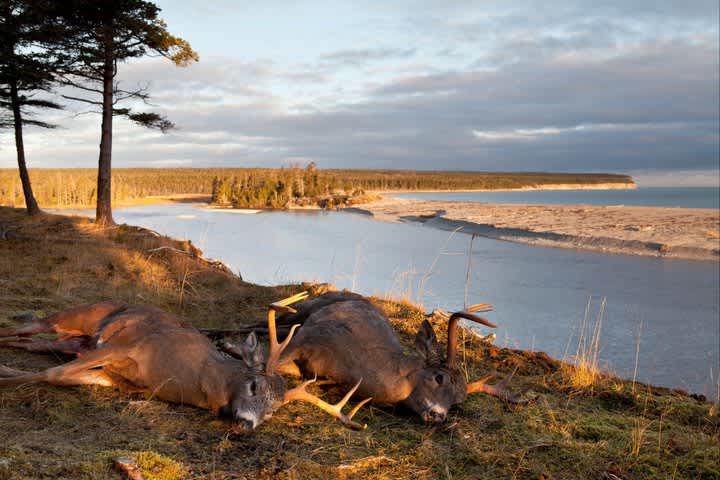A Truly Unique Hunting Experience: Anticosti Island, Quebec
Larry Osmer 10.17.11

Located in Quebec Canada, Anticosti Island sits at the mouth of the St. Lawrence River in close proximity to the tip of the Gaspe Peninsula in the Gulf of the St. Lawrence. This beautiful island is about half the size of Prince Edward Island and is 135 miles long with sections 10 to 30 miles wide. Carved out nearly 400 million years ago, Anticosti Island is unrivaled with its natural features. Along the coast, bright white jagged limestone cliffs saw tooth in and out of the blue waters and rocky coast. Starting inland, lush emerald green boreal forests run all the way to the shore line and along pristine beaches. It’s along these beaches you will often find herds of whitetail deer feasting upon the nourishing kelp that lay across the white sandy beaches. Inland rivers cut through deep canyons forming magnificent waterfalls that pour into crystal clear lakes scattered throughout the island.

The natural unspoiled splendor that is Anticosti Island is also what makes it one of the most beautiful places on earth to hunt whitetail deer. In 1895, Anticosti’s private owner, Henry Menier, transported approximately 200 deer to the island and by today’s count the deer have thrived to an estimated 125,000. Other animal species were also brought to the island such as bear, moose, fox and grouse. The once thriving black bear was hunted extensively on the island but now bear are basically extinct. Due to limited food sources like the wild berries on the island, the ever growing deer population nearly wiped out the abundant food sources the bear needed to survive the long cold winters. Fox, grouse and the occasional moose survived and continue to live on the island today, thus making Anticosti void of any predators. Winter along with hunting are the only population controls on Anticosti Island today, and winter wins that competition hands down.
The typical whitetail ranges from 165 to 200 pounds with 6 to 8 points and an average spread of 16 to 18 inches wide. From my own observations, there is a distinct appearance to an Anticosti whitetail’s antlers that is best described in color. The majority I have seen are either very light tan, almost white, or with a hint of color that resembles a light pumpkin orange color. This is just another characteristic of the Anticosti experience that makes it so unique. As a matter of fact, SCI has recently recognized the whitetails of Anticosti as a sub species and the current record is in the 146 inch SCI trophy class.
Anticosti Island is like no other hunting experience I have ever had before. For starters, getting there is very easy and regular flights from Montreal as well as Quebec make the trip out of New England extremely accessible. We typically drive from Maine to Quebec City where we overnight then fly out early the next morning allowing the travel experience to be more relaxing. It’s very common to bring supplemental provisions like food and beverages that are not always supplied by the lodge but is not required. The dining experience is out of this world. Three hardy and gourmet prepared meals are surely welcome after a long day in the field. During my second trip to Anticosti, we brought fresh Maine lobster and enjoyed a lobster bake while socializing on the deck of the lodge overlooking a beautiful river and serene ocean bay off in the distance.
Typically spot and stalk is the most common hunting method employed. In the absence of snow, the lush forest floor is abundant with soft moss making the stalk nearly silent, as distinct advantage indeed. Weather conditions can certainly make the circumstances challenging; the conditions can change from harsh wind and rain to blinding snow in an instant. If there is going to be a lot of snow in the higher elevations of the island, the deer will often migrate to the coastal areas where there is more food such as kelp, in abundance. Quite a few years ago I hunted the island after a harsh winter and its effects were distinct. Area guides reported that deer were caught in the higher elevations by twelve feet of snow and unable to migrate to the coast for sustenance, ultimately decimating that portion of the herd. Due to the resiliency of these tough animals it was not long before the numbers were back to normal again.
Anticosti Island has provided many fond memories, but one particular hunt was like nothing I had ever experienced before. It was mid day when I was dropped off by my guide. After going over the area map along with specific trail instructions, I began my quest for the island whitetail. Nearly an hour after my stalk began I could see an opening ahead, one that caught me off guard. As I approached, I could not help but notice the pronounced crashing of the surf or the roar of the ocean—I was at the edge of the island. Once I poked out of the dense forest canopy the view before me was breathtaking. While standing atop a towering limestone cliff, I gazed straight out towards the crystal blue ocean and watched the surf crash rhythmically into its pale white face. To my right lay a patch of kelp on the distant sandy beach. Seeing movement, I quickly raised my binoculars to witness a dozen different deer meandering while feeding along the shoreline. A few younger deer who ventured too far out scrambled in vain to avoid the crashing surf. In all my years of hunting I have never hunted amongst so many splendors. To whitetail deer hunt along towering cliff edges, pristine beaches, in a lush green forest, surrounded by my quarry was an experience of a lifetime and is one of my fondest memories afield to date.

